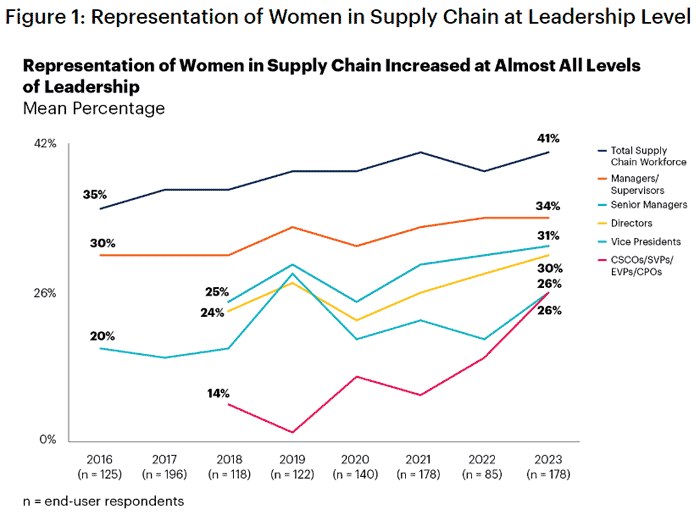Women in Supply Chain: Challenges & Opportunities
Every March, people worldwide celebrate women’s achievements and history as part of Women’s History Month. Beyond the theme of 2024, Women’s History Month continues the discussion of women in supply chains and their diverse perspectives, which can help address supply chain challenges and improve global supply chain operations.
The supply chain landscape has grown more diverse and dynamic in recent years, with women playing prominent roles. As the supply chain industry evolves, so must our understanding of leadership. Gender diversity is more than just a buzzword – it’s a strategic imperative. Studies show that diverse teams outperform homogenous ones – bringing perspectives, driving innovation, and experiencing a marked competitive advantage. There is a greater representation of women in different roles. However, there’s still plenty of room for further progress, especially in higher leadership positions.
How Well-Represented are Women in Supply Chain?
Women make up 41% of the supply chain workforce globally. (Gartner 2023)
One-third of high-growth businesses worldwide are now run by women (GEM’s 2021/2022 Women’s Entrepreneurship Report)
In 2022, women earned an average of 82% of what men earned in the US (Pew Research Centre’s The Enduring Grip of the Gender Pay Gap).
Since 2011, the amount of venture capital dollars granted to teams of only women in the US has ranged from 1.8% to 2.7% and currently stands at 2.0% (PitchBook’s Female Founders Dashboard 2023)

Challenges Faced by Women in Supply Chain Roles
Women have made a strong presence in the supply chain workforce. However, the gender gap regarding job positions, pay scale, and career growth opportunities remains prevalent.
Safety Concerns: The supply chain profession is often portrayed in inaccurate stereotypes involving heavy lifting and physical strength. Due to the sector’s pervasive image, women are not considered suitable for leadership roles.
Work-life balance Issues: Research shows that women are responsible for about one-third of their children, while men invest only 8% of their time.
While life partners can help share responsibilities and duties equally, there is a need to incorporate flexibility into work-life balance so that organizations can more fully leverage the benefits of skilled and talented women. According to PwC, only 52% of women identified their organization as a workplace where they can truly be themselves. Women can thrive where they feel they belong, are included in decision-making, and are treated equally and fairly.
Lower Representation: Networking is crucial in career advancement and growth by enabling access to mentorship and growth opportunities. Women feel less inclined to break into networks when they don’t see prospective peers in the room. Without female representation and mentorship, women struggle to envision themselves succeeding in the supply chain sector.
Initiatives for Women in Supply Chain
Here are a few key Initiatives that have emerged to support women’s career development and gender equality in global supply chains:
- Create mentorship programs pairing experienced professionals with women in the supply chain to provide career advice, guidance, and support.
- Conduct regular pay equity audits to ensure pay equity between men and women in similar roles within the supply chain.
- Provide leadership development programs focusing on negotiation, communication, and strategic decision-making.
- Schedule diversity and inclusion training to create an equitable and supportive work environment for women.
- Offer opportunities for women to participate in networking events and leadership seminars to enhance their leadership capabilities.
- Implement flexible work policies to accommodate the diverse needs of women in the supply chain, including options for remote and part-time work and flexible hours.
What’s Next for Women in Supply Chain
Women’s notable achievements demonstrate that they are uniquely positioned to lead the supply chain organizations of the future. A talent shortage continuously challenges the supply chain sector, and women represent a substantial resource. Organizations can expand their talent pool and address the talent shortage by recruiting, retaining, and advancing women in the supply chain industry.
Gender diversity can also help to challenge legacy-focused mindsets, embrace advanced technologies, and adapt to industry trends faster. A recent study claims that when women feel higher levels of workplace inclusion – they are 1.7 times more likely to seek new opportunities and learn new skills. Further, they are 1.5 times more likely to ask for a promotion.
Supply chain is a collaborative game; no one succeeds in supply chain alone. Women bring a more collaborative outlook to complement the supply chain industry. It is imperative to inspire inclusion and bring diverse perspectives of women to lead supply chain organizations with empathy, cooperation, and collaboration.
The future is female. Together, we can embrace diversity and create a more inclusive and equitable workplace for women in supply chain.
Related Articles


